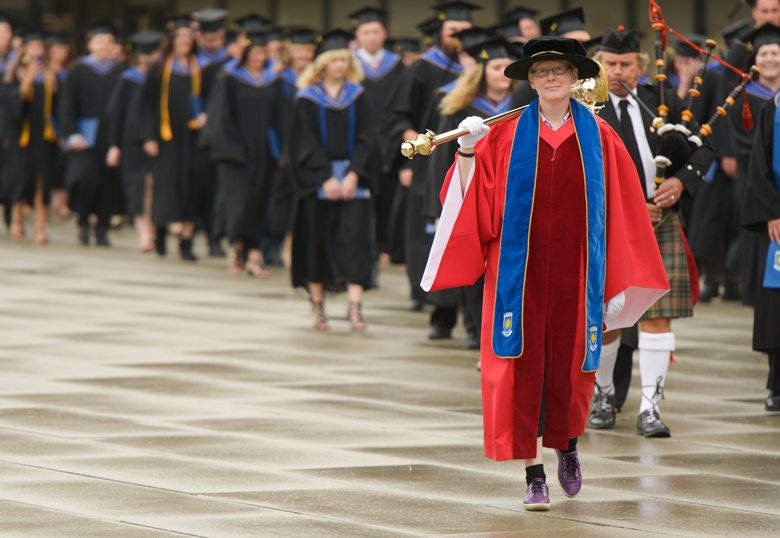As the campus community prepares to celebrate the Spring 2016 Convocation this week, we caught up with history professor Dr. Sheila McManus who says her role as chief marshal is, “The best job — ever.”
“As chief marshal, you have that final moment with every single student as they get ready to cross the stage, and you get to say ‘congratulations’ to each of them,” she says. “You get to play this little tiny part in their tremendous accomplishment. It really is the best job ever.”

Since first being handed the mace in 2013, McManus has witnessed nearly 3,000 students go from graduand to graduate. As chief marshal, she leads a team of seven other marshals and carries the mace while leading the academic procession and recession.
“The ceremony officially begins when we carry the mace into the room and it ends when we leave the room,” she explains. “We really are the protector of the ceremony. It’s a very specific symbolic combination: us, the mace and the students on their convocation day. That’s what we (the marshals) exist for.”
Even after all the convocation ceremonies McManus has attended, she says every ceremony is still emotional and makes her tear up.
“It’s that moment when we are walking up the hill and the parents and families are lined up waiting to take a photo of their student,” she says. “It’s also those moments after the ceremony when you see a student taking a photo with children and you realize, she’s a mother, or when you see the large extended families gathered or when you hear all the different languages being spoken and you realize just how multi-cultural the University is.”
Known for her iconic purple shoes, McManus is looking forward to convocation ceremonies this week with incredible excitement, and a little bit of sadness. The afternoon ceremony on Friday will be her last as chief marshal and she will turn the mace over to Dr. Olu Awosoga, a professor in the Faculty of Health Sciences.
“I’m sad to be done. I am happy that I am turning it over to a very dear friend who will be an amazing chief marshal. And I’m so grateful that I got to do this job.”
Some facts:
- The mace weighs 16 pounds. One end features three elements—mortarboard, gavel and open book. The mortarboard represents the Senate and symbolizes academia with all of its connotations. The gavel represents the Board of Governors and symbolizes management and control, while the open book represents the General Faculties Council and symbolizes teaching, scholarly activity and service. The other end of the mace features a globe set in pronghorn antelope antlers. These represent the mascot of the University and our commitment to the physical dimensions of the scholar. The globe symbolizes the universality of knowledge and liberal education in all its dimensions.
- The chief marshal decides if the procession walks inside or outside. “Unless it really isn’t possible, I always choose outside because the walk up the hill is regarded as part of the student experience at the U of L,” says McManus.
Some words of insight Sheila passes onto Olu as he prepares to take on the role of chief marshal.
- “Walk slowly. The walk up the hill is much slower than you realize.”
- “Wear cool shoes and bring dry socks for the afternoon ceremony.” (Hence the iconic purple golf shoes)
- “Wear shoulder pads (I may even bootleg mine to you). Between walking up the hill and standing as the students take their seats in the gym, you will have the 16-pound mace on your shoulder for a good 25 minutes.”
- “At some point during the procession up the hill, turn around. The view of the students lined up is amazing.”
